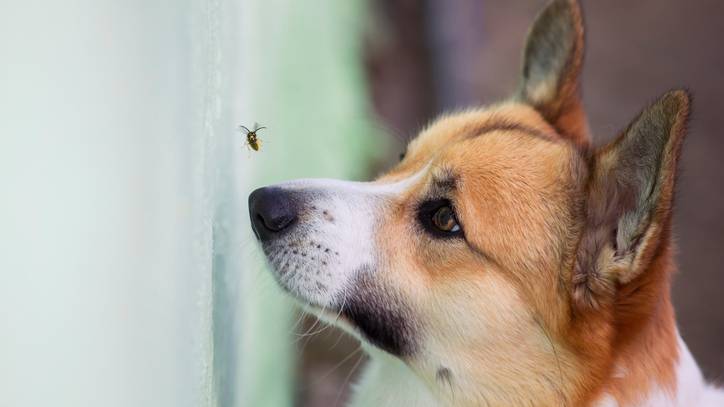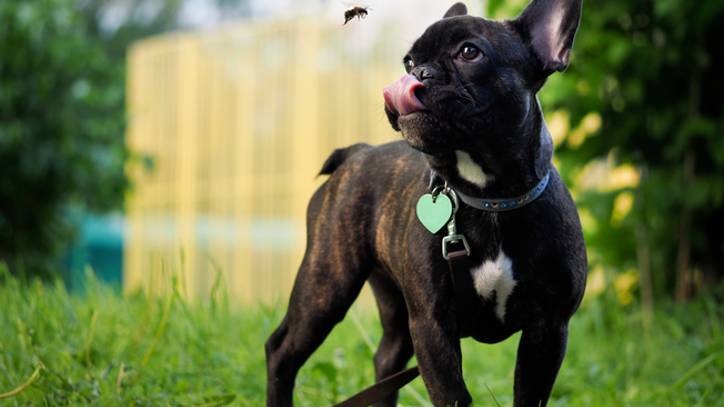Dog stung by a bee? Our vet explains what to do
Ouch! For a dog stung by a bee, the situation can be painful and frightening. Find out how to deal with it.

Summer’s on its way, with lots of fun activities such as beach walks and swimming. What’s not so fun, though, is the increase in insects. If your dog is stung by a bee or wasp, it’s important to act quickly. While your doggo might be lucky and get no more than a fright and is easily soothed with one of the best puppy toys, the situation might be a little more serious.
A lot of dogs are energetic and inquisitive, which makes them delightful companions. It also means, though, that they might stick their noses into a heap of trouble! Lively dogs sometimes chase bees and might even go and investigate a hive.
While most bee or wasp stings only cause mild irritation, if your pooch is stung multiple times or near a sensitive area such as eyes or mouth you could need to seek veterinary advice. Just like with humans, some dogs can have allergic reactions and will need urgent medical attention.
Read on for our vet’s guide to what to do if your dog has been stung by a bee or wasp.
Signs of a dog stung by a bee or wasp
Sometimes, you may actually see your dog stung by a bee. Some dogs like to snap at bees and you may see your pet jump or yelp when he gets stung.
In many cases though, pet owners do not witness the insect bite or sting and only see the symptoms that occur afterward.
Symptoms of an insect bite or sting can include:
Get the best advice, tips and top tech for your beloved Pets
- Swelling at the area of the bite or sting
- Redness
- Itching
- Sensitivity to the touch
- Warmth to the touch
- Whining
- Limping or holding up a paw (if stung on the paw)
- Pawing at the face or mouth (if stung on the face)
- Biting or pawing at the site of the stung
These symptoms are usually relatively mild and may not require veterinary care unless they are progressive or are accompanied by symptoms of an allergic reaction as discussed below.
Signs of allergic reaction in a dog stung by a bee
In some cases, your dog may have a more severe reaction after being stung by a bee. Signs of an allergic reaction can include:
- Facial swelling
- Difficulty breathing
- Hives
- Swelling of the mouth or throat
- Lethargy
- Vomiting
- Diarrhea
- Staggering
- Pale gums
- Collapse
If you notice these symptoms in your dog, seek veterinary care right away. These are signs of a severe allergic reaction and can progress quickly. Prompt treatment by your veterinarian is necessary to slow or stop the reaction and help relieve the symptoms.
What to do if your dog gets stung by a bee or wasp
First and foremost, don’t panic! A single bee sting is usually not a major concern. First, see if you can locate the area where the sting occurred.
If you can identify the stinger, remove it by gently brushing over it with your fingernail or a piece if gauze. Do not grab the stinger with your fingers or tweezers, as squeezing it can cause more venom to be released, which can worsen the reaction.
If you cannot locate the stinger, don’t worry – in many cases, we never find the stinger. Often, it falls out on its own.
Next, evaluate your dog for symptoms of a bee sting. It is common to have some localized swelling or pain at the site of the sting. Signs of a more significant allergic reaction – like facial swelling or hives – mean it’s time for a trip to your veterinarian for treatment.

How long does a bee sting last on a dog?
A single bee sting is typically mild and symptoms should only last about 12-24 hours before resolving completely. If your dog’s symptoms are more than mild or if your dog is developing new symptoms during this period, then it is time to see your veterinarian for an evaluation.
Multiple bee or wasp stings are much more serious than a single bee or wasp sting as your dog may receive more venom, which can be very dangerous. If your dog has received multiple stings, see a veterinarian right away for treatment.
Symptoms from multiple stings may take much longer to resolve, and your dog may need to be hospitalized for further care.
Treating a bee sting in dogs
If your dog displays symptoms of an allergic reaction, such as facial swelling, itching, or hives, it is important to see your veterinarian for treatment.
Your veterinarian will perform a quick physical examination on your dog, and will likely treat him with medications such as antihistamines and steroids to reduce the inflammation and slow the allergic reaction.
Your pet may also be sent home with some medication for the next few days to help manage the reaction. In most mild cases, this treatment is all that is needed. In severe cases, hospitalization and further treatment may be necessary.
Although one bee sting in dogs is usually easily treatable, multiple bee stings or being stung by a swarm of bees is a major concern. This is because the venom in bee and wasp stings can cause severe reactions such as anaphylaxis, hemolytic anemia, organ failure, and even death.
If your dog has experienced multiple stings, please take him or her to an emergency veterinary hospital right away for treatment.
Should I take my dog to the vet if she got stung by a bee?
If your dog received a single bee sting and has only mild symptoms and is otherwise doing well, you likely do not need to take your dog to the vet. The symptoms should resolve on their own within 12-24 hours.
If the symptoms do not resolve in this time period, if they worsen, or if your pet has symptoms of an allergic reaction, then he or she should see a veterinarian for evaluation and treatment.
If your dog was stung multiple times it is especially important to seek veterinary care right away, as this can result in severe illness and even death due to high doses of bee or wasp venom.
If you are ever unsure about whether or not your dog should see a veterinarian, it’s always best to see your vet to be on the safe side!
Dr. Elizabeth Racine is a small animal general practice vet covering all things pet health and wellness. Her special interests include veterinary behavior, nutrition, and internal medicine.
As a freelance writer, Dr. Racine has written content for major companies in the industry such as the American Kennel Club, Merck Animal Health, Bayer PetBasics, Elanco, and CareCredit. In her free time, Dr. Racine enjoys playing trampoline dodgeball, hiking with her beagle Dasher, and spending time with her three mischievous cats.

